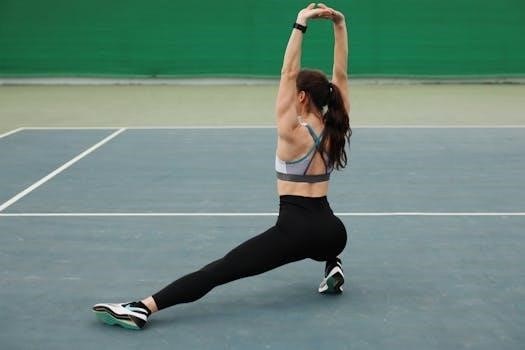Diastasis recti, the separation of abdominal muscles, is common, especially postpartum. Specific exercises can aid in recovery by targeting deep core muscles. Many traditional ab exercises should be avoided to prevent worsening the condition.

Understanding Diastasis Recti
Diastasis recti abdominis (DRA) refers to the separation of the rectus abdominis muscles, often occurring during pregnancy as the abdominal wall stretches to accommodate a growing fetus. The term ‘diastasis’ itself means separation, highlighting the physical gap that forms between the left and right sides of the abdominal muscles. This separation can manifest as a visible bulge or tenting along the midline of the abdomen, particularly during certain movements. It’s important to recognize that DRA isn’t just a cosmetic concern; it can impact core strength, stability, and even contribute to back pain or pelvic floor dysfunction. Many women experience this condition, but it can also affect men. Understanding the mechanism of DRA is crucial for selecting appropriate exercises that promote healing and avoid exacerbating the separation. The focus is on engaging deep abdominal muscles to gently support the separated tissue and encourage its natural repair. It’s essential to consult with a healthcare professional or physical therapist for a proper diagnosis and personalized exercise plan.

Safe and Effective Exercises for Diastasis Recti
Focus on exercises that engage the deep core muscles, such as the transverse abdominis, and avoid movements that cause bulging. Proper breathing techniques are key to safe execution of these exercises.
Deep Breathing and Core Engagement
Deep breathing exercises are foundational for healing diastasis recti, as they activate the transverse abdominis (TVA), the deepest abdominal muscle. Start by lying on your back with knees bent. Inhale deeply, allowing your belly to rise gently, and as you exhale, consciously engage your TVA by drawing your belly button towards your spine. This action isn’t a forceful contraction but rather a gentle, controlled pull. Focus on maintaining this engagement throughout the exhale. This technique is often referred to as “umbrella breathing” and can be combined with Kegel exercises to further strengthen the pelvic floor. It is crucial to avoid holding your breath and to ensure your diaphragm is moving properly. Practice this breathing technique multiple times a day to build awareness and strength in your core muscles. Consistent deep breathing with core engagement is essential for healing.
Pelvic Tilts (Various Positions)
Pelvic tilts are gentle exercises that help to engage the core muscles and improve stability, particularly beneficial for those with diastasis recti. These can be performed in various positions, including lying on your back with knees bent, on your hands and knees, or even standing against a wall. When lying down, gently tilt your pelvis backward, pressing your lower back into the floor while engaging your deep abdominal muscles. On hands and knees, slowly tilt your pelvis up, tucking your tailbone under, and then return to neutral. In a standing position, you can achieve a similar motion. The key is to perform these movements slowly and with control, focusing on the gentle engagement of the core. Pelvic tilts in different positions enhance core stability without putting stress on the abdominal separation. These exercises are safe and effective for strengthening the core and supporting diastasis recti recovery.
Abdominal Compressions
Abdominal compressions are a crucial exercise for addressing diastasis recti, as they focus on engaging the deep transverse abdominis muscle. This exercise involves gently drawing the belly button towards the spine, creating a sense of tightening in the abdominal area without any bulging. You can perform abdominal compressions in various positions, such as lying on your back with knees bent, seated, or even standing. The key is to maintain slow, controlled movements, focusing on the contraction of the deep core muscles rather than the outer abdominal muscles. During the compression, exhale slowly, feeling the abdomen flatten towards the spine. Avoid holding your breath. Repeat this controlled contraction, ensuring no straining or bulging. This exercise is very effective in strengthening the core and reducing abdominal separation by engaging the deep muscles. Incorporating abdominal compressions into your routine promotes healing and supports core stability without exacerbating diastasis recti.
Toe Taps and Heel Slides
Toe taps and heel slides are gentle, yet effective exercises ideal for individuals with diastasis recti, as they promote core engagement without excessive strain. To perform toe taps, lie on your back with knees bent and feet flat on the floor. Engage your core by drawing your belly button towards your spine and slowly lower one foot to lightly tap the floor, then return to the starting position. Alternate legs, maintaining control and avoiding any abdominal bulging. For heel slides, begin in the same starting position and slide one heel along the floor, extending your leg until it’s almost straight, then slide it back. Alternate legs, keeping the core engaged and the low back pressed into the floor to prevent arching. These exercises work the deep abdominal muscles and improve core stability. Remember to move slowly and focus on proper form. Both toe taps and heel slides are foundational exercises that are safe and effective for those recovering from diastasis recti by strengthening the core gradually without putting undue pressure on the abdominal muscles.

Exercises to Avoid with Diastasis Recti
Certain exercises can exacerbate diastasis recti. Avoid movements that cause abdominal bulging, such as crunches and sit-ups. Heavy lifting and strenuous bending should also be avoided to protect the abdominal muscles.
Strenuous Abdominal Exercises
Strenuous abdominal exercises, commonly performed to strengthen the core, can be detrimental for individuals with diastasis recti. These exercises, including traditional crunches, sit-ups, and planks, often cause the abdominal muscles to bulge outwards rather than drawing them inwards. This outward bulging can worsen the separation of the rectus abdominis muscles, hindering the healing process. Such movements place excessive pressure on the linea alba, the connective tissue between the abdominal muscles, potentially increasing the gap. Instead of these traditional exercises, focus on movements that engage the deep core muscles and promote proper muscle activation. It is important to choose exercises that do not cause the telltale “tenting” or doming of the abdomen, which indicates improper muscle engagement. Opt for gentle, controlled exercises that prioritize proper breathing and core engagement to encourage healing and reduce the severity of diastasis recti.
Heavy Lifting and Bending
Heavy lifting and bending activities can pose significant challenges for individuals with diastasis recti and should be approached cautiously. These actions often place considerable strain on the abdominal muscles, potentially exacerbating the separation of the rectus abdominis. When lifting heavy objects, the intra-abdominal pressure increases, which can force the abdominal wall outward and further stress the already weakened linea alba. Similarly, bending movements, particularly those involving twisting or forward flexion, can put undue pressure on the separated muscles. It’s crucial to activate the deep core muscles before engaging in any lifting or bending to help support the spine and abdomen. Learning to engage the transverse abdominis muscle can help provide stability and reduce the risk of further separation. Avoiding heavy lifting and extreme bending is vital in the early stages of recovery from diastasis recti. Focus on proper body mechanics and use supportive techniques to minimize strain on the abdominal area.

Additional Considerations
Postnatal core programs, diastasis recti exercises for men, and the role of deep abdominal muscles are important. These programs address individual needs with specific exercises and guidance for optimal recovery.
Postnatal Core Strengthening Programs
Postnatal core strengthening programs are essential for women recovering from childbirth, especially those experiencing diastasis recti. These programs focus on gentle, safe exercises designed to rebuild core strength and stability. They often incorporate deep breathing techniques to engage the transverse abdominis, a key muscle for closing the abdominal separation. Such programs also integrate pelvic floor exercises to restore overall core function. These programs are not just about regaining a flat stomach; they are about supporting the body’s natural healing process. They often include a gradual progression, starting with basic movements and slowly increasing the intensity as strength improves. It is crucial to find a program that is specifically designed for postpartum recovery and takes into account the unique needs of the recovering body. These tailored programs are more effective and safer than generic fitness routines, which can exacerbate the condition if done incorrectly. Consistency and patience are key to successful recovery.
Diastasis Recti Exercises for Men
While diastasis recti is more commonly associated with pregnancy, men can also experience abdominal muscle separation. This can result from weight fluctuations, heavy lifting, or certain types of exercises. Therefore, men too can benefit from specific exercises designed to address this condition. Similar to programs for women, these exercises focus on engaging the deep core muscles, especially the transverse abdominis. Breathing techniques are again essential to help activate these muscles effectively. Exercises like pelvic tilts, abdominal compressions, and heel slides can be beneficial for men. It is also important for men to avoid strenuous abdominal exercises and heavy lifting until the separation has healed. A tailored exercise plan for men should be adapted to their individual fitness level and the severity of their diastasis. Consulting with a physical therapist or a trainer experienced in this area can provide personalized guidance. The goal is to restore core stability and strength safely and effectively, regardless of gender.
The Role of Deep Abdominal Muscles
The deep abdominal muscles, particularly the transverse abdominis (TVA), play a crucial role in the recovery from diastasis recti. These muscles act like a natural corset, providing support and stability to the spine and pelvis. Unlike the rectus abdominis, which is responsible for the “six-pack” appearance, the TVA is a deeper muscle that is essential for core strength and function. In the context of diastasis recti, the TVA helps to draw the separated rectus abdominis muscles back together by creating tension across the abdominal wall. Engaging the TVA during exercises, including deep breathing and pelvic tilts, promotes healing and prevents further separation. Strengthening these muscles is key to restoring core strength and reducing the visible bulge associated with this condition. Neglecting the deep abdominals and solely focusing on superficial muscles can hinder recovery and potentially worsen the diastasis. Activating these deep muscles requires concentration and control, making it a cornerstone of effective diastasis recti exercises.
